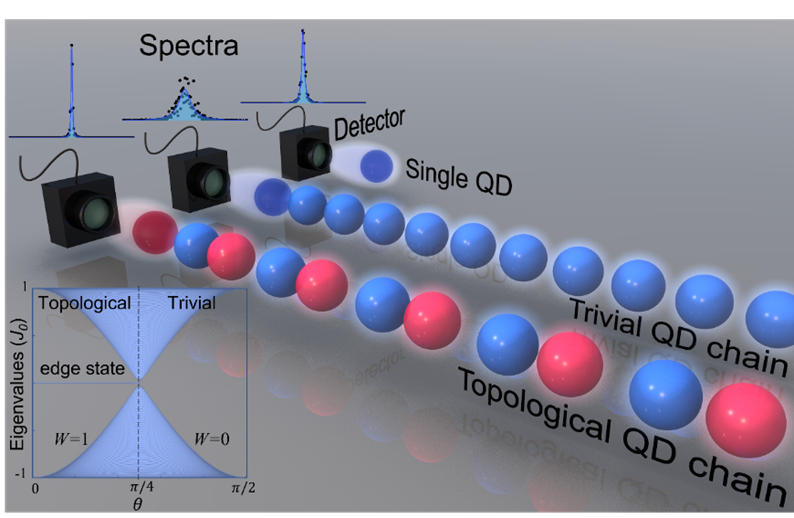Theoretical proposal for improving the indistinguishability of single photon emission
2024/01/30
Recently, the Ultrafast Optical Spectroscopy Group led by Professor Qihua Xiong at BAQIS and their international collaborators have made an important progress in the field of quantum optics and quantum information. The proposed idea significantly improves the indistinguishability of single photon emission by utilizing topological properties in the active quantum optical systems. The research results were published in the journal npj Quantum Information entitled "Topological single-photon emission from quantum emitter chains" on January 23, 2024.
Single photon emitters play crucial roles in the field of quantum information. Single photon sources with high brightness and indistinguishability are crucial components in the integrating quantum information chips. However, many single photon sources (such as semiconductor quantum dots) are adversely affected by phonon scattering and spectral diffusion, which cause detrimental spectral line broadening at higher temperatures. This greatly reduce the indistinguishability of single photons, which hinders the practical application and operation of single-photon sources at room temperature. Moreover, existing efforts to reduce line broadening often rely on external controls. To date, no research has explored the utilization of topological properties to protect and optimize single-photon emission.
In this work, the BAQIS team has proposed a novel theoretical scheme to improve indistinguishability of single photon emission. This scheme is based on a quantum Su-Schrieffer-Heeger (SSH) chain in one dimension composed of quantum dots (two-level quantum system). By tuning the hopping amplitude between quantum dots, the system can undergo phase transitions between topological trivial states and nontrivial states, and the photons emitted by quantum dots at the edge can be collected as for single photon generation (Figure 1). When the system is in a topologically nontrivial state, a significant decrease in emission line broadening can be observed compared to a single quantum dot and a chain structure in a topologically trivial state.

Figure 1 Comparison of emission spectra between a single quantum dot, quantum dot chain in a topologically trivial state, and quantum dot chain in a topologically non-trivial state.
The line width narrowing effect is particularly pronounced near the topological phase transition points, and the effect increases with the increase of the number of quantum dots in the chain structure. The statistical properties of the Hamiltonian of the system are further studied. It is found that the topological edge state appears in the topologically nontrivial region, and the distribution of the eigenenergy of the edge state appears as a significant constraint phenomenon near the topological phase transition point. This topological robustness is the mechanism behind the line width narrowing effect. In addition, the team further simulated the second-order correlation function and Hong-Ou-Mandel (HOM) interference effect of the system. The results verified the single-photon nature of the emission and the improvement of the indistinguishability. Further considering the experimental implementation of the model, the research team selected several common single photon sources as model systems and applied them to the micropillar and microcavity models, proving that the hopping amplitude can be tuned by changing the potential well depth of the micropillar, the quantum dot spacing and the coupling strength of the microcavity, so that the model has good experimental feasibility.
The co-first authors of the paper are Yubin Wang, a Ph.D. student in the Department of Physics at Tsinghua University and an intern of BAQIS, and Dr. Huawen Xu, a postdoctoral fellow at Nanyang Technological University. This work was envisioned and supervised by co-corresponding authors Dr. Sanjib Ghosh, Associate researcher at the Beijing Institute of Quantum Information Science, and Professor Qihua Xiong at the Department of Physics, Tsinghua University, and the team leader of the Ultrafast Optical Spectroscopy group at BAQIS. This research work was supported by the National Key Research and Development Program, the National Natural Science Foundation of China, and the Outstanding Youth Science Fund Project (Overseas).
Article link: https://www.nature.com/articles/s41534-024-00807-y
 中文
中文 Email
Email QCloud
QCloud Log in
Log in
